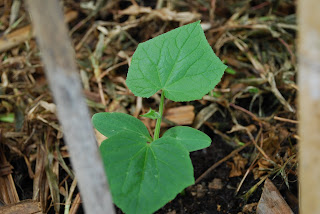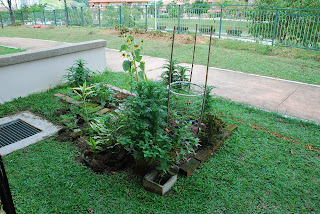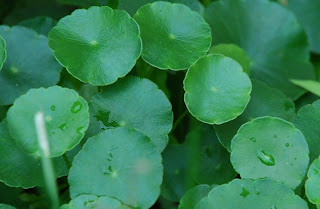I have to admit, growing new plants always comes with enthusiasm and anxiety. I don't think I ever see real cucumber plants growing. Then I search through, to get a fair idea how to handle cucumber. The notes are placed at the bottom of the post, and my adventure is in italic.
that trellis is meant for cucumber. Photograph was taken
immediately after the bamboos were staked down
on the 12th of May 2010.
Lilies at the front end, and kadok or
Piper sarmentosum
at the side. And containers alongside the house
Vegetable bed: soil and moisture
I spend an hour or two to get the bed ready. The spot was formerly filled up by ulam raja, and bitter gourd before that. While working out the soil to a depth of about 8 inches, I notice roots belonging to the nearby papaya and banana. Growing plants, digging and fluffing the soil allow us to recognize roots. I put the size of bed as 3x6 feet. The soil is healthy looking with lots of worms, creating tunnels and leaving their poo on the surface. I added goat's poo as fertilizer. It is said, that cucumbers can be grown on any soil type that has a high water-holding capacity and good drainage with a pH range of 5.5 to 7.0. The garden soil has good proportion of humus and clay, therefore water holding shouldn't be a problem. Being raised by about 5 inches, drainage is taken cared, but I don't know about the soil pH. I have asking around, about getting a suitable equipment to measure pH. So far, pH is basically my own visual estimate.. haha.
Nearby plants
Big plants nearby are papaya, banana and senduduk. Little plants at the edge of the bed are lilies, kadok and one ulam raja. As edging, I placed banana stem on one side. Bricks for potted plants will form the edge at another side. And the other sides, more or less served by kadok and lilies as edgings. It does look funny for a simple vegetable bed for cucumber to be guarded by many plants and material.
Pest and disease
As far as pest is concerned, I am wary of grasshoppers which have been feasting our leafy vegetables. Through readings, the common pest problem would be damping-off, nematodes, powdery mildew, and mosaic viruses. Damping-off and nematodes can be controlled by planting in clean soil or treating the soil with captan-terrachlor for damping-off and with nematicide for n ematodes. Powdery mildew can be controlled by using maneb, zineb, or copper fungicides. Watermelon mosaic virus may be a problem in certain areas at various times of the year. Lehua hybrid is highly resistant to this virus and should be grown where it is a problem.
Harvest:
Most cucumber varieties will produce fruit ready for harvest in 50 to 60 days. Frequency of harvest will depend on the vigor of the plant, the location, and the time of year. Usually every other day or daily harvest is necessary when the plants are growing vigorously at the lower elevations during the hot weather. Removing fruits as they mature will aid in maintaining the plant vigor and productive capacity.
bangchik and kakdah


















































